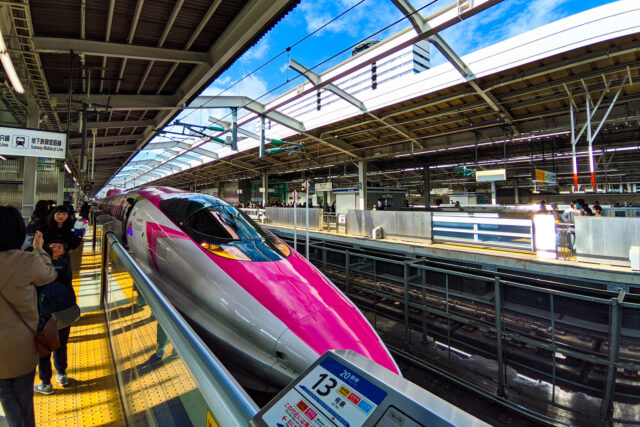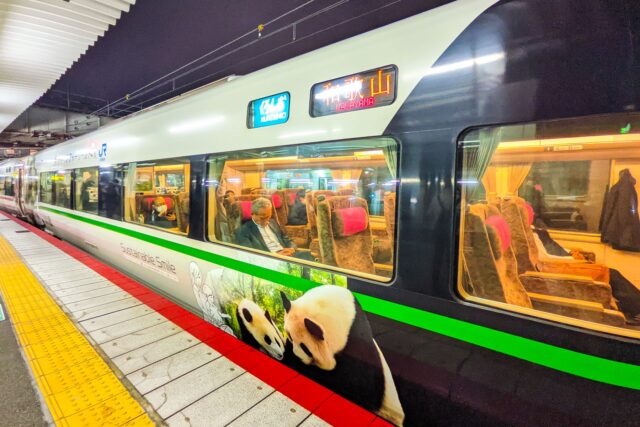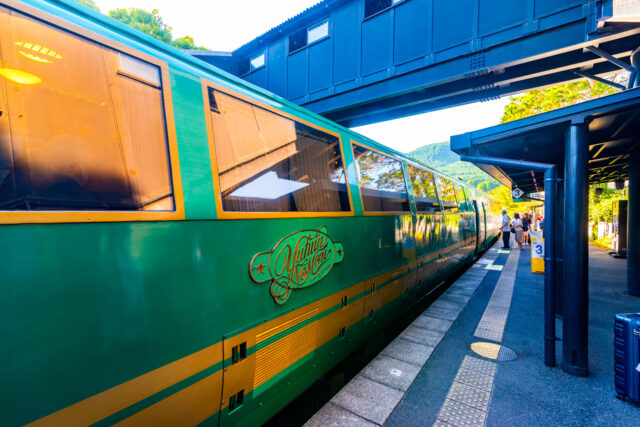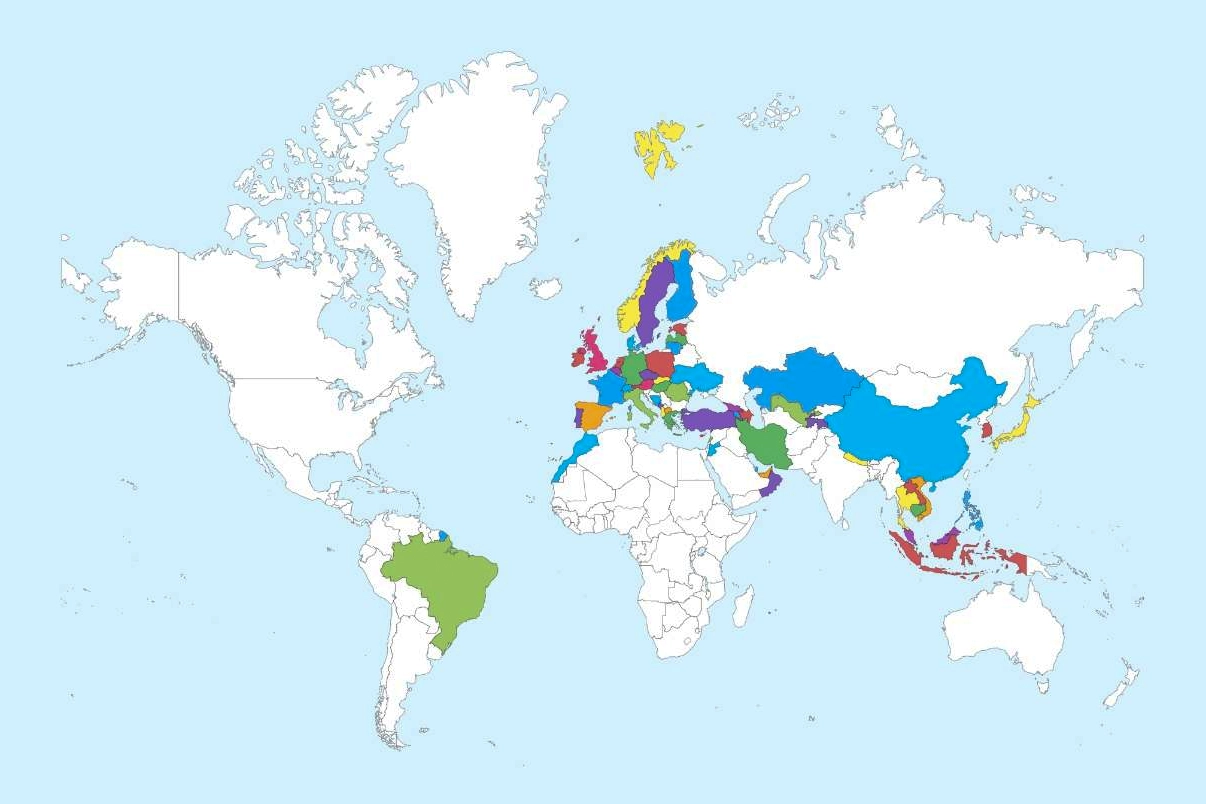Quick heads‑up, fellow travelers: Hit the Road Ket contains some affiliate links. Book through them and I earn a small commission at no extra cost to you – fueling my caffeine fix and future travels! For more details, see my Disclosures.
Most travelers have heard of the nationwide Japan Rail Pass, which lets you ride across the entire country on a single pass. But did you know there are Regional JR Passes too? And in many cases, they’re actually the smarter, savvier option.
These regional passes cover specific areas – sometimes just one prefecture, other times quite a wide are. Some of them, like the Sanyo–San’in–Northern Kyushu Pass, the East–South Hokkaido Pass, or the Hokuriku Arch Pass give you plenty of flexibility across a wide area – at a much lower price than the national pass or individual tickets. If you are not sure, if you should get a Regional Pass or which Pass should you get, this post is for you.
Whether you’re planning a deep dive into one region or hopping between a few connected ones, a regional pass might better match your actual itinerary, while also offering unique perks and access to sightseeing trains. So it’s definitely worth checking if a regional one gives you good value and freedom.
I have used both – nationwide JR and a Regional Pass (Sanyo San’in Northern Kyushu Pass) – and I have purchased individual tickets in Japan, therefore, I have made quite a lot of calculations for my trips to understand, which Passes offer better value and when should I opt out of buying one. Therefore, I am happy to share my insight.

- Things to Know about Regional Passes
- Temporary Visitors Stamp is Needed
- Regional Passes are Convenient
- Seat Reservations are Included
- Coverage Areas Vary by Pass
- Many Passes Cover Some Sightseeing Trains
- Reserving Seats Across Multiple JR Regions
- Valid on Consecutive Days
- Regional Passes are Physical Cards
- Comprehensive List of JR Regional Passes
- Non-JR Travel Passes
- Which Regional Pass? Sample Itineraries
- Tips on Booking and Using Regional JR Passes
Things to Know about Regional Passes
Temporary Visitors Stamp is Needed
These passes are only available to tourists. Specifically, you must be entering Japan under the “Temporary Visitor” status. If you’re living in Japan or hold a different visa (like student or work), you’re not eligible.
Make sure your entry stamp says “Temporary Visitor” – this will be checked when you collect your physical pass in Japan.
Regional Passes are Convenient
You can hop on any eligible train’s non-reserved car any time. This is certainly very handy, especially while doing day trips and you have no idea how much time you will need at a particular town until you get back to your hotel.
Missed your reserved train? No problem – just board the next one in a non-reserved car.
Note: Technically, you should cancel your reserved seat if you know you’re not going to use it, so it’s freed up for others. But realistically, if you’re rushing between platforms or short on time (like we often were), standing in line at the machines to cancel isn’t always doable. We’ve missed trains a few times and just moved on without canceling – not ideal, but sometimes unavoidable.
I have several stories, where the Pass came handy. For instance, when we found Hiroshima terribly crowded for the day and we couldn’t leave our bags anywhere, we simply hopped on a train and headed to Onomichi to spend our day there. We would hardly be able to do this without a Pass, as it would cost a lot. Another time, when we missed our train after a long day, we were happy we could simply hop on the next train, instead of the one we reserved.
Seat Reservations are Included
While hopping on non-reserved cars is easy (outside the busiest seasons), if you are travelling during the very busy period, with luggage, on long distances, or absolutely need to be on a train at a specific time, you better make seat reservations.
Normally, reserved seats cost extra – but with a pass, they’re included (even those with oversized luggage areas behind).
Coverage Areas Vary by Pass
The rules of coverage differ – some passes cover everything in a particular area, others have some exceptions. You need to double check each of their coverage on the official websites (linked below for each pass).
Example: JR West All Area Pass covers all of West Japan JR lines from Kanazawa to Hakata, with the exception of Tokaido Shinkansen and JR Kyushu shinkansen even within the coverage zone.
Many Passes Cover Some Sightseeing Trains
Just like the national JR Pass, most regional passes cover many Joyful Trains (those fun, scenic, character-themed trains).
Examples:
- JR Kyushu pass covers many of Kyushu’s amazing Joyful trains (like AsoBoy, Two Stars 4047, Yufuin-no-Mori and more).
- JR West All Area Pass covers Hanayome Noren, as well as Hello Kitty Shinkansen and more.
See my post about the joyful trains with details on Pass coverage.
See my post about Kyushu’s joyful trains with details on Pass coverage.
See my post about Kansai’s Joyful trains with details on Pass coverage.

Reserving Seats Across Multiple JR Regions
This applies to buying the passes from official websites: If your rail pass covers areas managed by two different JR companies — like the Sanyo-San’in–Northern Kyushu Pass, which includes both JR West and JR Kyushu — there’s a catch: You can only reserve seats online for trains operated by the company you bought the pass from.
Confusing, isn’t it? Here’s our example: We bought our Sanyo–San’in–Northern Kyushu Pass from the JR West website. That meant we could easily reserve seats online for JR West trains — but not for JR Kyushu ones. So when we tried to book sightseeing trains like Aso Boy!, it didn’t work online. We had to wait and reserve those at the ticket counter after arriving in Japan.
Valid on Consecutive Days
All of the Regional Passes are valid on consecutive days after you activate them. The validity is counted according to calendar days – whatever time you activate it on day 1 doesn’t matter, it will still be valid till 23.59 of day 7. You are allowed to finish your journey however, if you are already on the train at the time it expires. I haven’t seen any that doesn’t follow this rule, although there might be some – so double check your preferred Pass.
Example: Hokuriku Arch Pass is valid for 7 days. So if you activate it on, for instance, 1 June at 6pm, it will be valid until 7 June 11.59 pm.
Regional Passes are Physical Cards
Whichever method you use for purchasing the Pass – official websites, Klook or Trip.com, you need to pick the Pass up in person upon arriving to Japan. The pass is not transferable, and you need to have your ID to prove, it’s yours.
Any Regional Pass is a physical card and not replaceable in case of loss or theft.
Comprehensive List of JR Regional Passes
There are dozens of different Regional Passes, which range from a small area around one big city to coverage of the whole West Japan. The only thing is that most of these Passes last up to 7 days. Hopefully, 10-day or 2-week Passes will also become available. Those would certainly be great. JR East’s 10-day Pass, which was first introduced in 2025 could be the start of this trend.
JR East
| Pass Name | Duration | Key Areas Covered |
| JR East-South Hokkaido Rail Pass | 6 days | Tokyo, Sendai, Hakodate, Sapporo |
| Hokuriku Arch Pass | 7 days | Tokyo, Nagano, Toyama, Kanazawa, Kyoto, Osaka |
| JR Tohoku-South Hokkaido Rail Pass | 6 days | Tokyo, Tohoku region, Hakodate |
| JR East Pass (Tohoku area) | 5 or 10 days | Tokyo to Aomori region |
| JR EAST PASS- Nagano, Niigata area | 5 days | Tokyo, Nagano, Niigata |
| JR Tokyo Wide Pass | 3 days | Greater Tokyo area, incl. Nikko, Mt. Fuji |
| Sendai Area Pass | 1 or 2 days | Sendai city and surrounding areas |
JR Central
| Pass Name | Duration | Key Areas Covered |
| Takayama Hokuriku Area Pass | 5 days | Nagoya, Takayama, Kanazawa, Kyoto |
| Alpine-Takayama-Matsumoto Area Pass | 5 days | Toyama, Alpine Route, Matsumoto |
| Ise-Kumano-Wakayama Area Pass | 5 days | Ise Shrine, Kumano Kodo, Wakayama |
| Mt. Fuji-Shizuoka Pass | 3 days | Mt. Fuji, Shizuoka region |
JR West
JR West has the most variety of Passes available, which can fit anyone’s tastes.
| Pass Name | Duration | Key Areas Covered |
| JR West All Area Pass | 7 days | Kansai to Hakata (excludes Tokaido & Kyushu Shinkansen) |
| Sanyo-San’in Northern Kyushu Pass | 7 days | Kyoto, Hiroshima, Fukuoka, Northern Kyushu |
| Setouchi Area Pass | 7 days | Kansai to Kyushu via Seto Inland Sea |
| Kansai Area Pass | 1–4 days | Osaka, Kyoto, Nara, Himeji |
| Kansai Mini Pass | 3 days | Osaka, Kyoto, Nara |
| Kansai Wide Area Pass | 5 days | Kansai + Okayama, Kinosaki, Wakayama |
| Kansai – Hiroshima Area Pass | 5 days | Osaka, Kyoto, Hiroshima |
| Kansai – San’in Area Pass | 7 days | Osaka, Kyoto, Tottori, Matsue |
| Kansai – Hokuriku Area Pass | 7 days | Osaka, Kyoto, Kanazawa |
| Sanyo – San’in Area Pass | 7 days | Kyoto, Hiroshima, Matsue |
| Hiroshima -Yamaguchi Area Pass | 5 days | Hiroshima, Yamaguchi, Miyajima |
| Okayama-Hiroshima-Yamaguchi Area Pass | 5 days | Okayama, Iwakuni, Hiroshima |
| Hokuriku Area Pass | 4 days | Kanazawa, Toyama, Fukui |
JR Hokaido
| Pass Name | Duration | Key Areas Covered |
| Sapporo-Noboribetsu Area Pass | 5, 7, 10 days | Entire Hokkaido Island |
| Sapporo-Furano Area Pass | 4 days | Sapporo, Furano, Biei |
| Hokkaido Rail Pass | 4 days | Sapporo, Noboribetsu |
JR Shikoku
| Pass Name | Duration | Key Areas Covered |
| All Shikoku Rail Pass | 3, 4, 5, 7 days | Entire Shikoku Island |
JR Kyushu
| Pass Name | Duration | Key Areas Covered |
| All Kyushu Pass | 3, 5, 7 days | Fukuoka, Nagasaki, Kumamoto, Beppu, Kagoshima |
| Northern Kyushu Pass | 3 or 5 days | Fukuoka, Beppu, Yufuin, Nagasaki, Kumamoto |
| Southern Kyushu Pass | 3 days | Kagoshima, Miyazaki, Kumamoto |
| Fukuoka Wide Pass | 2 days | Fukuoka Prefecture only |
These are the Passes that are available all the time. There are also limited time Passes at times, when the transportation and some attractions are combined and made available with one Pass. These can usually be found on the websites of JR companies linked above.
Non-JR Travel Passes
While JR lines are the most extensive, there are other – non-JR – train lines around Japan, some of which do offer travel Passes. Some of the examples include:
| Pass Name | Operator | Duration | Key Areas Covered |
| Hakone Free Pass | Odakyu | 2 or 3 days | Hakone area (train, boat, cable car, bus) |
| Fuji Hakone Pass | Odakyu | 3 days | Fuji Five Lakes + Hakone |
| Hakone Kamakura Pass | Odakyu | 3 days | Hakone + Kamakura |
| Enoshima Kamakura Pass | Odakyu | 1 day | Kamakura, Enoshima |
| Nikko World Heritage Area Pass | Tobu | 2 days | Travel to shrines and temples in Nikko |
| Nikko All Area Pass | Tobu | 4 days | Full Nikko region coverage |
| Kintetsu Rail Pass | Kintetsu | 1, 2, 5 days | Osaka, Kyoto, Nara, Nagoya, Ise |
| Kansai Railway Pass | Various | Varies | Kintetsu, Hankyu, Keihan, and other non-JR lines in Kansai |
| Koyasan World Heritage Ticket | Nankai | 2 days | Osaka to Koyasan + temples, buses, cable car |
Which Regional Pass? Sample Itineraries
Please, note that not all of these passes are value-for-money for any traveler. They may work for you depending on your itinerary or not at all. However, there are some Passes, which are generally very good value for what they offer and could help many travelers out.
Some examples of itineraries, where the Regional Passes are a great value:
| Itinerary coverage | Relevant Regional Pass |
| 10-day itinerary – Golden triangle (Tokyo, Kyoto, Osaka) | None of the Passes |
| 10-day fast itinerary covering Tokyo and surroundings, Kanazawa area and Kansai (Osaka, Kyoto, Nara) | Barely breaks even with 7-day Hokuriku Arch Pass |
| One month itinerary – Tokyo, Kanazawa, Kyoto/Osaka/Nara, Himeji, Hiroshima, Northern Kyushu (with flight to Tokyo and from Osaka or vice versa) | Combination of two Passes as opposed to the All Japan Pass:
· Spend several days in Tokyo · Use 7-day Hokuriku Arch Pass on your exploration from Tokyo to Kanazawa and surroundings to Kyoto/Osaka, · Use 7 days to explore Kyoto, Osaka and Nara without a Pass · Use 7-day Sanyo San’in Northern Kyushu Pass to explore West Japan and Northern Kyushu and return to Osaka |
| 10-day itinerary of West Japan from Osaka/Kyoto, Okayama, Hiroshima areas | Sanyo San’in Area Pass or West JR All Area Pass |
Let’s do a breakdown of some of these itineraries:
|
10-day itinerary for your first visit |
||
| Day 1-3 | Arrival and Tokyo | |
| Day 4 | Travel Tokyo-Osaka | None of the passes would save money for this itinerary |
| Day 4-5 | Osaka | |
| Day 6 | Day trip to Nara (round trip) from Osaka | |
| Day 7-9 | Kyoto | |
| Day 10 | Travel back to Tokyo | |
|
2-week itinerary |
||
| Day 1-3 | Arrival and Tokyo | |
| Day 4 | Travel Tokyo-Kanazawa | Hokuriku Arch Pass: 30,000 yen
Barely breaks even, so probably just buy individual tickets. |
| Day 4-5 | Kanazawa | |
| Day 6 | Travel Kanazawa-Osaka | |
| Day 7 | Day trip to Nara | |
| Day 8-9 | Kyoto | |
| Day 10 | Travel back to Tokyo via Hokuriku Arch – appr. 5 hours with Hokuriku Arch Pass | |
As you can see the Pass may be useful, although the savings aren’t all that huge in this case, while trip Kyoto to Tokyo is longer by about two hours (as you would not be able to take a direct train from Tokyo to Kyoto and instead have to go via Kanazawa/Tsuruga).

|
One-month itinerary |
||
| Day 1-5 | Arrival and Tokyo | |
| Day 6 | Travel from Tokyo to Nagano | You could use Hokuriku Arch Pass for day 6-12 |
| Day 6-7 | Explore Nagano area | |
| Day 8 | Nagano to Kanazawa | |
| Day 8-9 | Explore Kanazawa | |
| Day 10 | Day trip to Shirakawago by bus | |
| Day 11 | Travel from Kanazawa to Kyoto | |
| Day 12 | Day trip to Nara from Kyoto | |
| Day 13-15 | Explore Kyoto | No Pass |
| Day 16-19 | Explore Osaka | |
| Day 20 | Day trip from Osaka to Himeji | |
| Day 21 | Travel from Osaka to Hiroshima and explore Hiroshima | You could use Sanyo-San’in Northern Kyushu Pass for days 21-27 |
| Day 22 | Day trip to Miyajima Island from Hiroshima | |
| Day 23 | Travel from Hiroshima to Fukuoka and explore Fukuoka | |
| Day 24 | Day trip to Nagasaki | |
| Day 25 | Day trip to Yufuin | |
| Day 26 | Day trip to Kumamoto | |
| Day 27 | Travel from Fukuoka back to Osaka | |
| Day 28-30 | Osaka and day trips | |
As you can see with this long itinerary you could best combine two of the Regional Passes, while not use any passes during the days you are more thoroughly exploring bigger cities.
|
10-day itinerary for second visit to Japan |
||
| Day 1 | Arrive to Osaka | |
| Day 2 | Travel from Osaka to Hiroshima and explore Hiroshima | Use Sanyo-San’in Northern Kyushu Pass on days 2-8 |
| Day 3 | Day trip to Miyajima Island from Hiroshima | |
| Day 4 | Travel from Hiroshima to Fukuoka and explore Fukuoka | |
| Day 5 | Day trip to Nagasaki | |
| Day 6 | Day trip to Yufuin | |
| Day 7 | Day trip to Kumamoto | |
| Day 8 | Travel from Fukuoka back to Osaka | |
| Day 9-10 | Explore Osaka or Kyoto or Nara | |
This itinerary is only relevant either if you already explore Kyoto and Osaka or if you have more time in West Japan to explore them. For instance, if you have 2 weeks, you can spend 7 days out of them on Kyoto and Osaka without a Pass and 7 others on the trip to Hiroshima and Kyushu with the Pass.
This is actually the itinerary we did on our second trip to Japan and it worked out really well. So if you are only planning to explore west Japan, consider getting the West Japan All Area Pass or any of the other passes that cover the area you want. If you, like me also want to include parts of Kyushu, then the Sanyo-San’in Northern Kyushu Pass is perfect.
To sum up, Regional JR Passes could be great value for your itinerary, but then again, they may not. So check against your own timeframe and itinerary before deciding, which one to get.
Tips on Booking and Using Regional JR Passes
If you do decide to buy it however, the rules of use are practically the same, as with regard to the nationwide JR Pass:
You have several options to purchase the Regional Passes:
- Relevant JR websites online: Each region of Japan has its JR network, so according to which Pass you want to purchase, you need to choose from the websites of either JR East, JR West, JR Hokkaido or whichever applies. All relevant websites are linked in my list above. You can purchase them 1 month in advance, no earlier. Purchasing from official websites gives you one advantage – you will be able to reserve seats online on many routes. But there are exceptions – for instance, we were unable to book Kyushu sightseeing trains online, when we purchased Sanyo San’in Northern Kyushu Pass from JR West.
- Designated agencies, such as Klook and Trip.com: We used Klook for JR pass. In this case you get a voucher. The delivery was quick – it arrived within three days. I was actually afraid of this, because postal services around here aren’t known for efficiency. One note though – in this case you can’t reserve seats online, before arriving to Japan. You will need to do that at the machines or ticket offices.
See also
Comprehensive guide to Japan, which will help you in trip planning
Comprehensive guide to train travel in Japan
Still not sure which if any Regional JR Pass suits your trip? Drop your itinerary in the comments or DM me – I’ll help you figure it out!



